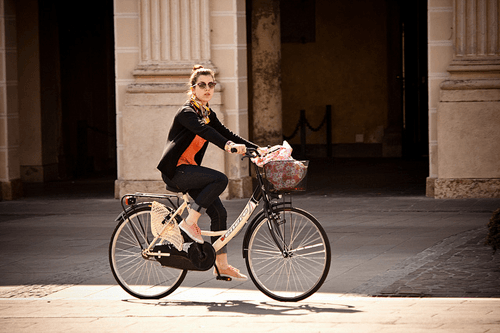Planning on cycling to work? More than a century has passed since mass-produced bicycles hit the streets, but we still haven’t agreed on the ideal cyclist’s day outfit. Generations of ladies that pedal know what it doesn’t exclude: your right to stay feminine.
Bike:
Any bike is a good commuting bike, but most people opt for road bikes – lightweight and dependable, with minimal room for unexpected malfunctions. They are common, and not too flashy, with less chance of being stolen. If you regularly stop at the market after work, simply attach a basket or a cargo rack. Storage shouldn’t be a problem either, with secure bike racks available at most business districts and ranks of cyclists working in any and every company, already having won the right for inside storage. If you are still unsure of your company policy on bicycles, folding bikes are a great option.
 A new trend is rising, however, specifically one of great value to middle-aged business women – electric bikes, or e-bikes. As weary as you are at the end of the day, these pedal-assisted bikes have an integrated electric motor to help you out.
A new trend is rising, however, specifically one of great value to middle-aged business women – electric bikes, or e-bikes. As weary as you are at the end of the day, these pedal-assisted bikes have an integrated electric motor to help you out.
Cycling gear:
Most of the regular cycling safety gear, including helmets, is not as compulsory as you think. Though it is definitely a good idea to put safety first, most city commuters have decided to eschew the bulkier safety measures in favor of packing light. So long as your lights, brakes and reflective strips are in perfect order, you too can be choosy with any add-ons.
Mudguards, on the other hand, are your best friend in rainy weather. They range from the least functional, but easiest to adjust clip-ons, to full-length tour-bike mudguards, which will also help keep your skirt out of the wheels.
Invest in a multitool and a patch kit. Flat tires are all-too-common with bicycles, regardless of road quality. Knowing how to fix your own flat means you will never be stranded in the middle of the city during rush hour with an entirely useless bicycle weighing you down, and no immediate way to get to the mechanic.
Outfit:
You will generate plenty of heat when you ride, so so be mindful of your outerwear. Cool weather does not necessarily mean thick coats. You’ll want to keep the wind away from your heated body, so choose something thin, preferably layered, and zip up. What you wear on the inside is much more important. Avoid cotton close to your skin since it dries out the fastest, making your undergarments cold and unpleasant. Nylon and wool are the way to go to manage heat, sweat, and bodily odors, the most common cycling issues.
Skirts and pants getting caught on chains, wheels, pedals, the brake – this is an everyday trial for bike commuters, women more so. Other than the aforementioned full-length mudguards, the Penny in Your Pants trick will keep your skirt in check – simply hold a coin behind your skirt, above knee height, and tie it into the fabric with a rubber band, from the front. You should end up with something resembling a cloth-covered button in the front of your skirt, connecting the front and back panels, and the freedom to wear your skirt as long or wide as you wish.
Corduroy or wool pants should probably not be your first choice in riding gear because riding will easily wear out the material on the derriere and the thighs. Pant legs can be kept out of the chain by simply tucking them in your socks while you ride, or tying them off with an ankle strap. Ankle straps are usually made from reflective materials and they serve a double purpose when visibility is down.
Shoes are never a problem. You can invest in clip less shoes for maximum stability and support, but there is really no need to, unless you have a hybrid or a mountain bike, and plan on using it for what it was designed. Any shoe, boot, and, yes, even heel, will do, so long as they have good grip on the bottom. Even if they don’t, rubber stick-on soles can be bought at pretty much any shoe or general store.


